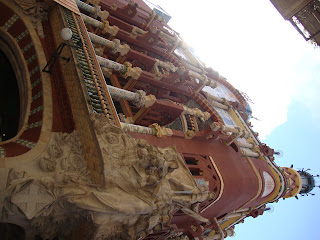Our last couple of days we hit Barcelona, and there are so many things I want to go back and spend more time at. Some of the highlights I hit:
2. Park Guell: this place was cool, but absolutely mobbed. You could barely walk. I was really excited to see this park, but I’d love to go back to Barcelona on the off-peak (or maybe just not Holy Week) because the crowds at this place were unbelievable. I bought postcards that had pictures because it was really difficult to get good ones and it was hard to get a sense of the place when you can barely see anything not right in front of you. The project designed by Gaudi was supposed to be a housing development for the wealthy. Can you imagine living in a house like this? Looks like a gingerbread mansion. When the idea didn’t catch on, the city turned it into a public park.
 |
| One of the houses that was never actually lived in |
 |
| Part of the cistern system, on the ceiling of what would have been the town hall and market area |
3. Gaudi’s famous houses La Pedrera and Casa Batlló. La Pedrera looks a little sinister, with its metal balconies (not very well featured in the photograph below) and Casa Batlló looks like a snake or dragon with its colored scales.
 |
| La Pedrera |
 |
| Casa Battlo on the right, with the curved roof. You can't see the colors of the facade as well in this picture. That's why I bought the postcard. |
4. I was in Barcelona on St. George’s Day. St. Jorgi is the patron saint of Barcelona and the people love him, he’s everywhere in this city. St. George shares his day with Shakespeare and Cervantes, who both died on this day. To celebrate, women buy books for the men in their life (husbands, fathers, brothers, etc.) and the men buy their women roses (they symbol of St. George)! All over the city there were stands run by different organizations selling books and roses on the street. This is my kind of city.
5. Palau de la Musicia Catalana: translated as the Palace of Catalan Music. This place is a beautiful Modernista concert hall. I took a tour (unfortunately you can’t take pictures inside) and it was really beautiful! All of the design is made to make the audience feel like they are in a garden, connected with nature. The beautiful ceiling in the middle of the room dips into the concert hall and is decorated to look like a sun. It’s stained glass and lets in a lot of light, which is incredible considering the concert hall was surrounded by tall buildlings and narrow streets. Aside from a small courtyard entrance, it still is. Even though I didn’t get pictures of the inside (again, I bought postcards), the outside is still pretty remarkable.
And that’s my tour de force of Spain! Being there for Holy Week was interesting--it was cool because there was so much energy and excitement in the cities we visited, but things were closed or altered due to processions which, if you're only visiting for a day, made it hard to see certain things, like the Sagrada Familia in Barcelona. The Sagrada Familia is a Mondernista-style neo-Gothic cathedral still being built according to the designs of the architect Gaudi, who designed the two houses that I mention above. The cathedral is not even finished yet! All the more reason to go back!






















